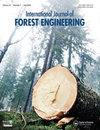Comparing single-wheel attachable tracks to chains and bare tires on skidders for mitigating soil disturbance during harvesting operations
IF 2.1
3区 农林科学
Q2 FORESTRY
引用次数: 0
Abstract
ABSTRACT Tree-length harvesting with skidders is common in the Northeast US. Traditional rubber-tired skidders (with and without chains) make repeated passes over skid trails during a timber harvest. This traffic causes rutting and compaction which can lead to concentrated surface run-off and sediment delivery to streams. An innovation referred to as attachable tracks for wheeled logging equipment is designed to improve traction and reduce ground disturbance. In theory, increased traction could reduce rutting (negative soil displacement) and improve tire flotation and compaction while providing loggers with an accessible and durable tool. We examined rutting, soil bulk density and mechanical resistance using attachable single-wheel tracks versus traditional chains and bare tires in a randomized controlled study. Soil bulk density did not differ among the three tire cover types. Bare tires caused the least mechanical resistance followed by tracks then chains. After one year of recovery of the skid trails, bare tires resulted in the lowest mechanical resistance and single-wheel tracks the highest. Soil profile measurements were similar across the three tire cover types with very shallow rutting that was less than 5 cm; however, tracks did create statistically significantly deeper ruts than bare tires and chains. These results do not make a compelling case that single-wheel tracks have less impact on forest soils compared to either chains or bare tires.将单轮附加轨道与链条和滑板上的裸轮胎进行比较,以减轻收获作业期间的土壤干扰
摘要:在美国东北部,用集材机收割树木很常见。传统的橡胶轮胎集材机(带链条和不带链条)在木材收割过程中会反复经过滑道。这种交通会造成车辙和压实,从而导致地表径流集中,并将沉积物输送到溪流中。一种被称为轮式伐木设备可连接轨道的创新设计旨在提高牵引力并减少地面扰动。理论上,增加牵引力可以减少车辙(负土壤位移),改善轮胎漂浮和压实,同时为伐木工人提供一种可接近和耐用的工具。在一项随机对照研究中,我们使用可连接的单轮履带与传统链条和裸轮胎进行了车辙、土壤容重和机械阻力测试。土壤堆积密度在三种轮胎覆盖层类型之间没有差异。裸露的轮胎造成的机械阻力最小,其次是履带,然后是链条。经过一年的防滑道恢复,裸露轮胎的机械阻力最低,单轮履带的机械阻力最高。三种轮胎覆盖层类型的土壤剖面测量结果相似,车辙很浅,小于5厘米;然而,从统计数据来看,赛道确实比裸露的轮胎和链条产生了更深的车辙。这些结果并不能令人信服地证明,与链条或裸轮胎相比,单轮履带对森林土壤的影响较小。
本文章由计算机程序翻译,如有差异,请以英文原文为准。
求助全文
约1分钟内获得全文
求助全文

 求助内容:
求助内容: 应助结果提醒方式:
应助结果提醒方式:


